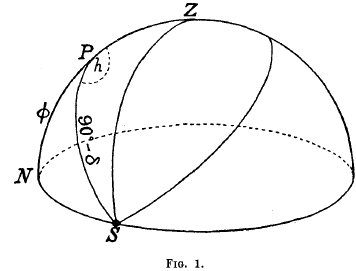No CrossRef data available.
Article contents
XVIII.—Sunset and Twilight Curves, and Related Phenomena.
Published online by Cambridge University Press: 15 September 2014
Extract
§ 1.THE objects of the present paper are, first, to describe certain curves which approximate to the graphs of the time of sunset (or sunrise) and end of twilight (or daybreak) all the year round for various latitudes; second, to tabulate the yearly phenomena of light and darkness for different latitudes under various conditions.
The time of sunset depends upon the latitude and the sun's declination,

and the extent of its variations depends upon the obliquity of the ecliptic. The extent of the variations of twilight depends also upon a certain angle a, which is the maximum depression of the sun's centre below the horizon for which the light reflected by the upper strata of the atmosphere is sensible.
- Type
- Proceedings
- Information
- Copyright
- Copyright © Royal Society of Edinburgh 1908
References
page 313 note * The effect of the equation of time, reducing apparent time to mean time, will be most marked in low latitudes, and it will produce a skewness in the curve, displacing the maximum towards the autumnal equinox and, if the latitude is sufficiently small, producing another maximum a little before the vernal equinox. The minimum will be intensified and displaced also towards the autumnal equinox. In what follows we shall consider only apparent time.




